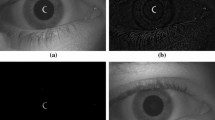Abstract
As a criterion used to describe the performance of an optical system, optical transfer function (OTF) can be calculated by autocorrelation of pupil function, dual Fourier transform, Zernike polynomial fitting, and so on. A fast OTF calculation method based on dual Fourier transform and graphics processing unit (GPU), in which the redundant computations of point spread function (PSF) and OTF are removed, is proposed in this paper. For an optical system with the pupil function of 512 × 512 pixels, the OTF computation is implemented on GPU platform. The result shows that the proposed method using the 128 × 128 pixels central regions of the PSF enhances the computational efficiency of about 4.88 times than the method using standard CUFFT.







Similar content being viewed by others
References
Consitt, F.J.P., Mandler, W.: OTF Techniques in the routine testing of production lenses. J. Mod. Opt. 18, 123 (1971)
Kondo, H., Watanabe, T., Yamaoka, H.: Criteria for the evaluation of photographic lenses. J. Mod. Opt. 22, 353 (1975)
Lu, S., Zhang, X., Guo, R., Xia, D., Yu, J., Han, J.: Research on measuring optical transfer function. Proc. SPIE 7849, 784931 (2010)
Joshi, N., Richard S., Kriegman D.: PSF estimation using sharp edge prediction. In: IEEE Conference on CVPR (2008)
Codona, J.L.: Differential optical transfer function wavefront sensing. Opt. Eng. 52, 097105 (2013)
Hopkins, H.H.: The frequency response of a defocused optical system. Proc. R. Soc. A 231, 91–103 (1955)
De, M.: The influence of astigmatism on the response function of an optical system. Proc. R. Soc. A 233, 91–104 (1955)
Black, G., Linfoot, E.H.: Spherical aberration and the information content of optical images. Proc. R. Soc. A 239, 522–540 (1957)
Hopkins, H.H.: The aberration permissible in optical systems. Proc. Phys. Soc. B 70, 449–470 (1957)
Hopkins, H.H.: The numerical evaluation of the frequency response of optical systems. Proc. Phys. Soc. B 70, 1002–1005 (1957)
Goodbody, A.M.: The influence of spherical aberration on the response function of an optical system. Proc. Phys. Soc. B 72, 411–424 (1958)
Goodbody, A.M.: The influence of coma on the response function of an optical system. Proc. Phys. Soc. B 75, 677–688 (1960)
Biswas, S.C., Boivin, A.: Influence of primary astigmatism on the performance of optimum apodizers. J. Opt. (Paris) 4, 1–11 (1975)
Biswas, S.C., Boivin, A.: Influence of spherical aberration on the performance of optimum apodizers. Opt. Acta 23, 569–588 (1976)
Biswas, S.C., Boivin, A.: Performance of optimum apodizers in the presence of primary coma. Can. J. Phys. 57, 1388–1396 (1979)
Schwiegerling, Jim: Relating wavefront error, apodization, and the optical transfer function: on-axis case. J. Opt. Soc. Am. A: 31, 2476–2483 (2014)
Barnden, R.: Calculation of axial polychromatic optical transfer function. Opt. Acta 21(12), 981–1003 (1974)
Zielinski T.P.: Robust image-based wavefront sensing. University of Rochester (2011)
Katsaggelos, A.K., Lay, K.T.: Maximum likelihood blur identification and image restoration using the EM algorithm. IEEE Trans. Signal Process. 39(3) (1991)
Math Kernel Library (MKL). Intel Corp. http://software.intel.com/en-us/articles/intel-mkl/
CUDA (version 6.5). NVIDIA. http://developer.nvidia.com/cuda/cufft
CUDA Toolkit 4.0 Performance Report. https://developer.nvidia.com/sites/default/files/akamai/cuda/files/CUDA_4_0_Math_Libraries_Performance_6_14.pdf
Galizia, A., et al.: Compute intensive algorithm on heterogeneous system: a case study about Fourier transform. In: 22nd Euromicro International Conference on Parallel, Distributed and Network-Based Processing (PDP). IEEE, Torino (2014)
Zhang, T., Shen, J., Hong, H.: Restoration algorithms for turbulence-degraded images based on optimized estimation of discrete values of overall point spread functions. Opt. Eng. 44, 017005 (2005)
Farber, R.: CUDA application design and development. Morgan Kaufmann, Burlington (2011)
Volkov, V., Brian, K.: Fitting FFT onto the G80 architecture (2008). http://www.cs.berkeley.edu/~kubitron/courses/cs258-S08/projects/reports/project6_report.pdf
Govindaraju, N.K., et al: High performance discrete Fourier transforms on graphics processors. In: Proceedings of the 2008 ACM/IEEE conference on Supercomputing, pp. 1–12. IEEE Press, Piscataway (2008)
Acknowledgments
This work was funded by the National Natural Science Foundation of China (Grant No. 11178004) and Library Innovation Foundation of the Chinese Academy of Sciences (Grant No. YJ14K018). We also acknowledge the reviewers whose comments are very valuable and helpful for revising and improving this paper.
Author information
Authors and Affiliations
Corresponding author
Rights and permissions
About this article
Cite this article
Zhang, Q., Bao, H., Rao, C. et al. A fast calculation method of optical transfer function using GPU parallel computation. Opt Rev 22, 903–910 (2015). https://doi.org/10.1007/s10043-015-0141-2
Received:
Accepted:
Published:
Issue Date:
DOI: https://doi.org/10.1007/s10043-015-0141-2




